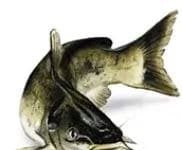The summer season isn’t complete without a wet wading trip to one of Oklahoma’s clear-water streams! Oklahoma streams are filled with an array of catchable species, highlighted by the smallmouth bass. While the state has an abundance of clear-water rivers and creeks, only a handful have public access opportunities. In this guide we’ll break down the top tips for catching smallmouth bass as well as the best public access destinations.
Oklahoma is home to three strains of smallmouth bass, the non-native Tennessee strain and the native Neosho and Ouachita strains. The Tennessee strain has been used to stock lakes across the state due to its penchant for slow flow living and larger attainable weight. Neosho and Ouachita strains like the faster flowing streams and rarely exceed 14 inches. There is overlap where Neosho and Ouachita strain watersheds are impounded by reservoirs that have been stocked with Tennessee strain (Neosho: Arkansas River Drainage; Ouachita: Red River Drainage).
Smallmouth bass are best caught during the late-spring, summer and early fall when water temperatures are above 60°F. Smallmouth bass can be caught on artificial lures and flies as well as natural/live bait.
Fishing tips
Smallmouth bass stream fishing offers a great opportunity during the dog days of summer to still get in on great fishing action. Summer fishing in ponds, lakes and reservoirs can be slow during the midday hours for bank anglers as the shallow water is just too warm for fish to be comfortable, but flowing streams come into their prime during the summer months. As fish retreat to shady or deeper areas of a stream during the midday hours, they are still very accessible to bank and wading anglers.
The biggest factor toward successful smallmouth bass stream fishing is water clarity. It is important to monitor rain forecasts and water gauges for optimal fishing conditions. The slightest stain in an otherwise clear-water stream can shut the bite completely down. Fortunately, if it’s not flooding, Oklahoma’s streams clear up quickly. If you don’t live in the area you’re fishing or know how to decipher USGS stream gauge data, you can always contact the local Game Warden for stream conditions at public access sites in their area.
Soft plastic grubs, tubes, swim-baits, worms and creatures in the 1.5″ to 3″ variety paired with a 1/32nd to 1/16th ounce jig-head are going to yield the most bites. Keep your offering in shades of green, brown, black, white or orange. Soft plastic baits labeled green pumpkin are a great starting point.
Larger soft plastic baits in the 3″ to 5″ variety usually need to be paired with a 1/8th to 1/4th ounce jig-head, but can be quite effective for big fish in the deepest holes and runs.
Crank-baits and jerk-baits in shad, bluegill and crayfish patterns will find success. As will naturally colored swim jigs and bladed jigs paired with a similarly colored soft plastic trailer. Inline spinnerbaits in shades of green, brown, black and white in the 1/8th to 1/4th ounce variety can produce bites in pools and runs.
Early morning and late evening hours can produce willing topwater takers. Walk-the-dog lures, poppers, buzz-baits and frogs are good options for drawing surface strikes.
Fly anglers can find success stripping jig-head and bead-head flies like Clouser Minnows and Woolly Buggers. Hatches such as mayfly and caddis provide dry fly opportunities along with terrestrial patterns like hoppers and stimulators. Stonefly, pheasant tail and rubber-legged yellow sally nymphs are also effective.
Approach runs, riffles, boulders and woody structure from downstream and make casts upstream or cross current and work your lure back to you without allowing it to get more than 45° downstream of you during the retrieve. Fish are looking to receive food from upstream or from ambush positions. Working a run or riffle section from upstream creates too many water disturbances that can spook fish, so it is always best to approach from downstream.
Pools can be fished this way as well, but can also be approached from upstream casting into the pool and allowing your lure to fall to the bottom then jig the lure back during the retrieve or if you have enough weight to hold the bottom, slowly retrieve the lure along the stream-bed. Try to make casts from a standing position that is least likely to send sediment and other disturbances into the pool.
Top habitat to target
Woody structure – roots wads, log jams and tree lay-downs will hold fish all day long.
Boulders – large rocks or rocky outcroppings create prime ambush spots and also funnel food.
Riffles – these are shallow areas where current speeds are fast in relation to the rest of the stream. Look for seams and eddies created by woody structure or boulders that create soft water for fish to stay out of the faster current.
Pools – particularly the beginning of the pool where the shallow riffle section dumps into the pool. Pools are created by turns in the river or natural impediments like log jams.
Runs – a run is the section between a pool and riffle where water depth and current speed are consistent. Boulders, cut-banks, rocky bank outcroppings and woody structure are great places to target in a run. These areas often hold the largest fish.
Tail-outs – the area at the end of a run where current speed increases as water moves into a riffle section. Tail-outs with shaded areas or a piece of structure are most desirable.
Rod/reel setup
Light up to medium action rod (5′ up to 7′ rod)
Spinning, spin-casting or casting reel
4-pound test up to 8-pound test line (monofilament or fluorocarbon line)
Top lures
Tube
Curly Tail Grub
Twin Tail Grub
Creature
Fluke
Topwater
Top bait
Natural/live bait can be drifted below a bobber or fished off the bottom with weight. Small- to medium-sized bait holding hooks and 1/8th to 1/2 ounce weights are ideal tackle.
Hellgrammite
Crayfishes
Short-Horned Grasshoppers
Crickets
Nightcrawlers
Red Worms
Try on the fly
Interested in fly fishing for smallmouth bass in Oklahoma for the first time? Check out Native Waters Outfitters for guided opportunities this summer. Native Waters Outfitters are proud partners of ODWC’s Stars and Stripes Program as well as Project Healing Waters Fly Fishing, a non-profit organization serving wounded military service members at Walter Reed Army Medical Center returning from combat in Iraq and Afghanistan.
Rod/reel setup
3-weight up to 7-weight fly rod with floating fly line, a 7.5′ or 9′ 6x up to 0x leader and 1 to 2 feet of 6x up to 0x tippet.
Top flies
Stripping Flies
Nymph Flies
Dry Flies
Public access highlights
Barren Fork Creek
Blue River
Honobia/Three Rivers WMA
Illinois River
Mountain Fork River
Rock Creek
This 2-hour virtual course covers the ins and outs of clear-water streams bass fishing in Oklahoma, including fishing tips, where to go and what to look for to be successful.
Click here to purchase a license.
Credit: Source link






























